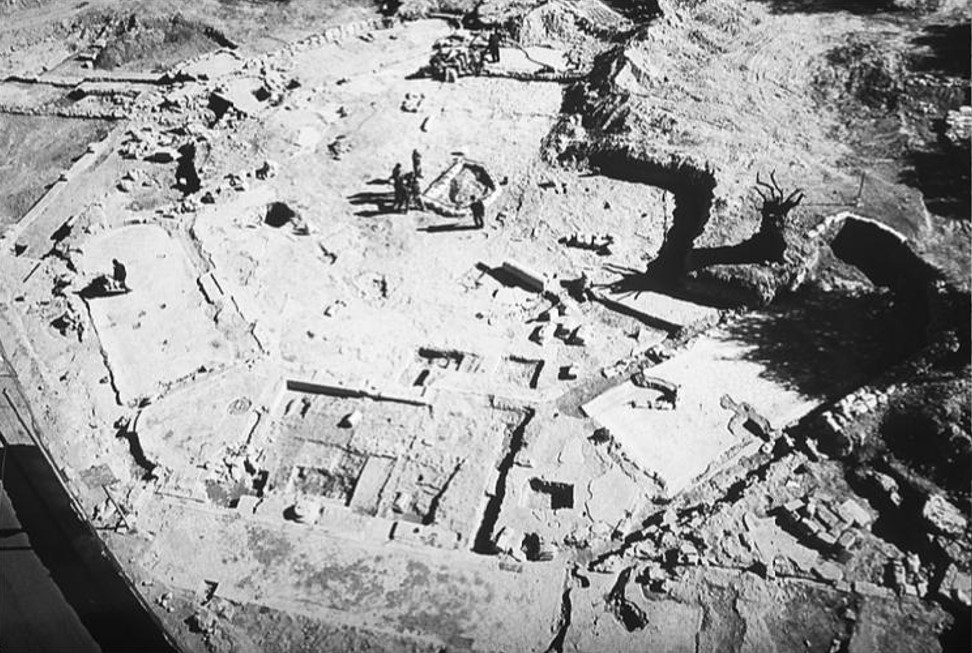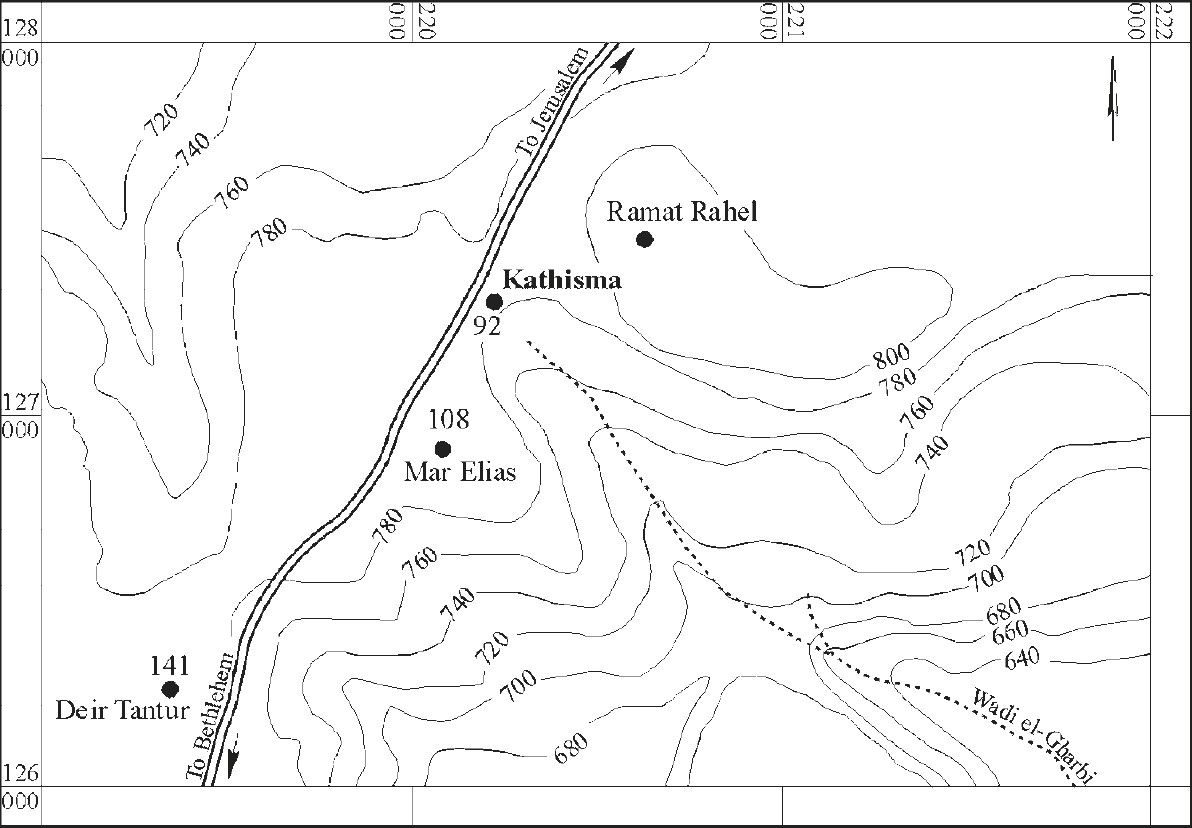Kathisma
 Figure 2
Figure 2Aerial photo of the Kathisma Church. View to the south-east, the main apse on the right unexposed
Avner (2007)
| Transliterated Name | Source | Name |
|---|---|---|
| Kathisma | Greek | κάθισμα |
| Ecclesia Kathismatis | Latin | |
| Kadismou | Arabic | كاديسموو |
| Church of the Kathisma | ||
| Old Kathisma |
The Church at Kathisma begins with a story.
In the 17th paragraph of the apocryphal
Gospel of James, Mary had a vision
three miles outside of Bethlehem and went into labor. Over time, it appears
that a legend grew and Mary was said to have rested on a rock while experiencing the pains of childbirth. In the 5th century CE, a church was built around this
supposed rock. The church was called
Kathisma and Kathisma became a pilgrimage site dedicated to Mary.
Sometime after the Muslim conquest of Jerusalem, the church at
Kathisma began to receive Muslim pilgrims. Mary is mentioned 70 times in the Quran and is referred to as the
greatest of all women
. In the 19th Surah (verses 24-25), the story of Mary at Kathisma is told in a slightly different way.
In the Muslim account, which shares similarities with the 20th chapter of the Gospel of Pseudo-Matthew, Mary retreated to the trunk of
a Palm tree and lamented that she wished she were dead. A voice rang out to reassure her and told her that a stream was beneath her feet and that if she shook the tree, she would
receive some dates.
The remains of the church at Kathisma, ~ 3 miles from Bethlehem and close to Ramat Rahel,
was discovered by accident in the early 1990's and excavated over 4 seasons. Much of the remains were missing - pilfered long after
its demise and it is this pilfering which may have removed any obvious archeoseismic evidence from earthquakes which
struck in the mid 8th century CE.
- Fig. 1.1 - Location Map
from Avner (2016)

 Figure 1.1
Figure 1.1
Location Map
Avner (2016)
- Fig. 1.1 - Location Map
from Avner (2016)

 Figure 1.1
Figure 1.1
Location Map
Avner (2016)
- Annotated Google Map
of the area from biblewalks.com
- Kathisma in Google Earth
- Kathisma on govmap.gov.il
- Annotated Google Map
of the area from biblewalks.com
- Kathisma in Google Earth
- Kathisma on govmap.gov.il
- Plan of the Church from
Stern et al (2008)

 Kathisma: plan of the church.
Kathisma: plan of the church.
Stern et al (2008)
- Plan of the Church from
Stern et al (2008)

 Kathisma: plan of the church.
Kathisma: plan of the church.
Stern et al (2008)
- from Avner (2016)
- There is no mention of archeoseismic evidence in any of the reports I have read
| Phase | Period | Age (century CE) |
Comments |
|---|---|---|---|
| 1st | Byzantine | 1st half of the 5th | The dating of the original first phase, according to coins retrieved underneath the lowest floors and their beddings,This date is supported by historical sources (see Avner, 2007) |
| 2nd | Byzantine | 1st half of the 6th | The second phase of the church is dated by coins retrieved above the floors of the first phase and below the floors Avner beleives the rebuilt church is referred to as New Kathisma in historical sources. |
| 3rd | Umayyad | 1st half of the 8th | The third phase is dated by coins, pottery and glass fragments to the first half of the eighth century - see Avner (2007) |
| Stratum III |
Ottoman | This stratum was attributed to the Ottoman period, based on ceramic finds that were discovered on surface.- Avner (2005) |
Avner, R., 1993 Jerusalem, Mar Elias, in Excavations and surveys in Israel 13: 89-92.
Avner, R., et al. (2001). "Jerusalem, Mar Elias – the Kathisma Church."
Hadashot Arkheologiyot: Excavations and Surveys in Israel
Avner, R., 2003 The Recovery of the Kathisma Church and Its Influence on Octagonal
Buildings, in Bottini, G.C. et al., 2003 One Land – Many Cultures:
Archaeological Studies in Honour of S. Loffreda, Jerusalem: 173-86.
Avner, R., 2005 Jerusalem, Mar Elias – the Kathisma Church, in Hadashot
Arkheologiyot 117
Avner-Levy, R. 2006-2007. The Kathisma: A Christian and Muslim Pilgrimage Site. ARAM 18-19:541-57
Avner, R. (2010).
"THE DOME OF THE ROCK IN LIGHT OF THE DEVELOPMENT OF CONCENTRIC MARTYRIA IN JERUSALEM: ARCHITECTURE AND ARCHITECTURAL ICONOGRAPHY." Muqarnas 27: 31-49.
Avner, Rina (2016)
The Initial Tradition of the Theotokos at the Kathisma: Earliest Celebrations and the Calendar in
The Cult of the Mother of God in Byzantium: Texts and Images. (2016). (n.p.): Taylor & Francis.
Avni, Gideon (2014).
"A Tale of Two Cities". The Byzantine-Islamic Transition in Palestine: An Archaeological Approach. Oxford Studies in Byzantium. Oxford: Oxford University Press. pp. 150–151.
Johann Gildemeister, ed. (1882). Theodosius: De situ Terrae Sanctae im ächten Text und der
Breviarius de Hierosolyma vervollständigt. Bonn: Adolph Markus. p. 28 - open access at archive.org
Oded, L., et al. (2011).
"PALACE AND VILLAGE, PARADISE AND OBLIVION: Unraveling the Riddles of Ramat Rahel." Near Eastern Archaeology 74(1): 1-49.
Pixner, B. (2013). Sulle strade del Messia. Luoghi della chiesa primitiva alla luce delle nuove scoperte archeologiche, EMP.
Katja Soennecken, 2006, Ramat Rachel in the Byzantine Period (Masters Thesis)
The Protoevangelium of James aka the Gospel of James - a 2nd century infancy gospel written in Greek - see paragraph 17
The Gospel of Pseudo-Matthew - a 6th or 7th century infancy gospel written in Latin - see Chapter 20
R. Avner, The “Kathisma”: Its Identification and Place in the History of Architecture
and the Art of Mosaic during the Byzantine and Early Islamic Periods (Ph.D. diss.), Haifa 2006
id., The
Kathisma Church and Monastery: Final Report (IAA Reports), Jerusalem (forthcoming).
Von Riess, ZDPV 12 (1889), 19–23
A. M. Schneider, JPOS 14 (1934), 230–231
P. Testini, Excavations at Ramat Rahel, Seasons 1959 and 1960 (by Y. Aharoni et al.
Universita di Roma, Centro di Studi
Semitici, Serie Archeologica 2), Roma 1962, 73–91
id., ibid., Seasons 1961 and 1962, Roma 1964, 101–
106
A. Charbel, La Terra Santa 51 (1975), 225–230
C. Nauerth, Dielheimer Blätter zum Alten Testament
26 (1992), 58–69
R. Avner, ESI 13 (1993), 89–92
20 (2000), 101*–103*
113 (2001), 89*–92* (et al.)
id.,
JSRS 8 (1998), xviii–xix
10 (2001), xxii–xxiii (with S. Pony)
13 (2004), xiv–xv
id., One Land—Many
Cultures, Jerusalem 2003, 173–186
J. Poulin, MdB 83 (1993), 43
Y. Tsafrir et al., Tabula Imperii Romani,
Iudaea Palestina: Eretz Israel in the Hellenistic, Roman and Byzantine Periods, Maps and Gazetteer (Publications of the Israel Academy of Sciences, Section of Humanities), Jerusalem 1994, 101–102
Archaeology
51/1/(1998), 28
V. Shalev, Historical Context, Structure and Function in the Churches of Palestine in Late
Antiquity (Ph.D. diss.), Tel Aviv 1999 (Eng. abstract)
S. J. Shoemaker, ASOR Newsletter 50/1 (2000), 10;
50/3 (2000), 12
L. Di Segni, Aram 15 (2003), 247–267
id., One Land—Many Cultures, Jerusalem 2003,
187–188.


